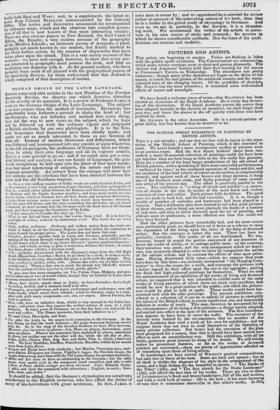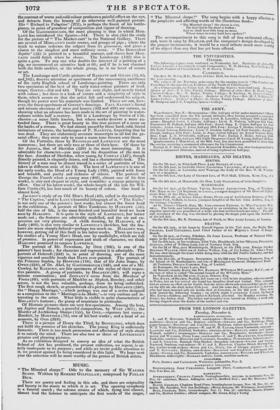THE SUFFOLK STREET EXHIBITION OF PAINTINGS BY BRITISH ARTISTS.
Tim is a sad mistake ; and one that we fear will do injury to the repu-
tation of the British School of Painting, which it was intended to exalt. We never beheld a more incongruous medley of pictures even in an auction-room. Had the first dozen brokers' shops been ran- sacked; a more ill-assorted collection of paintings could not have been got together than are here hung as foils to the few really fine pictures. Here are a number of the least happy productions of the old school of
British painters, with a sprinkling of their more successful performances, "mellowed by time," as the combined operation of smoke and dirt, and the exudation of the foul vehicle of colour on the surface, is complacently termed ; and against each of these brown and dingy pictures, is hung one of the freshest, most crude, and flashy paintings of some second- rate artist of the present day. The effect is positively painful to the sense. The exhibition is " a thing of shreds and patches"—a succes- sion of shocks to the eye, by means of the most harsh and violent contrasts of tone and colour. Each picture kills its fellow. The good ones are made to look bad, and the bad execrable. It is as though a jumble of snatches of melodies and harmonies had been played as a concert. Had a deliberate plan been formed to rob a few good pictures of their charms, and to bring out more glaringly the faults of a number of had ones, and thus to throw discredit upon the art of painting, and ridicule upon its professors, a more efficient one than this could not have been devised.
Had the older pictures been remarkably bad, and the more recent ones particularly good, we should have set it down as a scheme to raise the reputation of the living upon the ruins of the fame of deceased artists. But the converse is rather the case. There has been no partiality, certainly. The works of all are deteriorated. We are,
however, bound to acquit the parties concerned of any intention to lower the credit of artists, or to outrage public taste : on the contrary, their intention was good; and the very arrangement which we depre-
cate, was purposely adopted in order to show by comparison the merits of the various artists, and by contrast the effects of time upon paint- ings. Having discovered their error—which we suppose they must have done by this time—we seriously recommend "the Hanging Com- mittee" to close the rooms for a week, and rearrange the pictures with a better regard to their effect upon the eye in the aggregate ; putting the fresh and high-coloured paintings by themselves. When we read the announcement of an exhibition of the works of living and deceased artists, we supposed that it was intended to exhibit some of the early works of living painters, of which there are many very excellent, that
would be new to a great portion of the public, and which the picture- seer would be glad to look at again. Those works would have har-
monized well with the older paintings. The present exhibition, con- sidered as a selection (if it can be so called) of pictures to exemplify the talent of the British school, is a most injudicious one, and lamentably deficient in works of merit. This may, however, be accounted for by the circumstances of its being a first attempt—a design hastily adopted, and carried into effect at the spur of the moment. The first considera-
tion appears to have been to cover the walls. The resources of the Society were limited by the circumstance, that no member of the Royal Academy dare send a work of his own for exhibition; and we suppose there was not time to avail themselves of the liberality of many private collectors. But better had the execution of the plan been postponed for a season, than that it should have been carried into effect in such an unsatisfactory way. Still this exhibition, with all its faults, possesses great interest in many of its details. -We will briefly notice its prominent features, as far as the works of deceased painters are concerned,—there are plenty of opportunities afforded us of remarking upon those of living artists. In Landscape, we have several of Wilson's poetical compositions, but only two or three of his best. Some are hard, and opaque ; but in all there is visible the elegance of his style to the arrangement of the scene, and a high feeling for the beautiful. in nature. The Banks of the Tiber" (102), and The first sketch for the Niobe Irandscape"
(134), will afford the best idea of his works. There are two or three of Lirnieenouito's fresh and breezylandscapes, full of life and motion,
and with a vivid look of nature : 128 is the best ; it has more harmony of tone than is sometimes observable, 41 this artist's works. In 3151, the contrast of warm and cold colour produces a painful effect on the eye, and detracts from the beauty of an otherwise well-painted picture. Bis" Richard in Palestine" (272), is perhaps the finest of his battle- pieces, in point of grandeur of composition and vigour of drawing. Of the GAINSBOROUGHS, the most pleasing is that in which Mon- LAND has introduced the figures-144. There is also (65) the study for the picture of" The Market-cart" in the National Gallery. There are several of MORLAND'S rustic scenes, and groups of pigs ; where the truth to nature redeems the subject from its grossness, and gives a charm to the simplest and most ordinary scene. " The Benevolent Squire" (55) is painted in a beautiful manner, and shows how Mon- LAND could finish when he chose. The Landscape (132). also is quite a gem. To any one who doubts the interest of a painting of a pig, we recommend an attentive look at 69; and if he is not charmed with the little welder, or the whole group, he is no lover of nature or art.
The Landscape and Cattle pictures of BARRETT and GILPIN (11,85, and;182), deserve attention as specimens of the unassuming excellence of the early English school of Landscape-painting. There are only two specimens of the best of the early water-colour painters of land- scape, GinTiN-354 and 444. They are very slight, and merely tinted with colour ; but there is a look of nature and a simplicity of style in them, which assure us that the artist felt and understood his subject, though his power over his materials was limited. These are not, how- ever, the finest specimens of GIRTIN'S drawings. PAUL SANDBY'S literal and minute elevations of trees and houses (332 and 493) are curious, as showing what an advance has been made in the art of painting in water- colours within half a century. 103 is a Landscape by SMITH of Chi- chester—a name little known, but whose works deserve a more ex- tended fame. There is great beauty in this true picture of a scene on the banks of a stream. We had almost passed by those hard, cold, literal imitations of nature, the landscapes of P. NAsmrrii, forgetting that he was dead. They are elaborately accurate transcripts in all but the ge- neral effect ; they seem only to want a warm tone thrown over them. Of the Portraits, those by REYNOLDS and LAWRENCE are the most numerous ; but there are only two or three of their best. Of those by Sir JosiitrA, that of Sheridan (229) is the most interesting. It is admirable for character—you may read the disposition of the man in the face. Another of Sheridan, when young, by COSWAY (147), though flimsily painted, is elegantly drawn, and has a characteristic look. The history of a man may be almost traced in a series of portraits of him, taken at different wras of his life. The best of LAWRENCE'S is one of his early works, the Head of a Young Lady (193), painted with force and breadth, and purity, and richness of colour. The portrait of George the Fourth when a young man (402), almost one of his first works, is airy and elegant in style, and resembles a crayon painting in effect. One of his latest works, the whole-length of the late Sir Wil- liam Curtis (9), has lost much of its beauty of colour. One band is almost livid.
JACKSON'S study of an Old Man's Head (43), called in the catalogue "The Captive," and in LANE'S beautiful lithograph of it, " The Exile," is not only one of the painter's best works, but almost the finest head in the exhibition. A portrait of Miss Tomkison, by HARLOWE (54), half the size of life, is the most finished and beautiful head we have seen by HAnLowe. It is quite in the style of LAWRENCE, but better made out ; the features are admirably modelled, and the air and ex- pression are very pleasing. A chalk drawing, by HARLOWE, of a Lady (403), is also very similar to LAWRENCE'S sketches, but the fea- tures are more sharply defined—perhaps too much so. HARLOWE was, however, getting rid of this fault in his latter works. There are two of his studies of a Young Man's Head, one by candlelight, which are full of promise. In power of expression and truth of character, we think HARLOWE promised to surpass LAWRENCE. The portrait of Mr. Newnham, by ONE (106), is one of the painter's best heads ; for character and expression it is admirable. The portrait of Holcroft (243) is, in point of drawing, one of the most vigorous and sensible heads that DAWE ever painted. The portrait of the Princess Sophia, by HOPPNER (118), that of Sir John Soane, by OWEN (218), of Dr. Abel, by GAINSBOROUGH (143), and one of a Mr. Cowley, by RAEBURN, are fair specimens of the styles of their respec- tive painters. A group of portraits, by HOGARTH (68), will repay a minute examination; and ZOFFANY'S scene from the Merchant of "Venice (89), with portraits of Macklin as Shy/ock, Hensley, and other actors, is not the less valuable, perhaps, from its being unfinished. The first rough sketch, or groundwork of a picture, by HoGmern (248), the" Happy Marriage,"—which perhaps was one of a series designed as a companion to the " Marriage-a-la-Mode,"—is very curious and in- teresting to the artist. What little is visible is quite characteristic of HOGARTH'S humour; the group of musicians in particular.
Of Historic pictures there are very few specimens. Among the best, are Jupiter and Semele, a graceful composition, by WEST (311). the Murder of Archbishop Sharpe (155), by OPIE,—vigorous but coarse ; Banditti, by MORTIMER (73), one of his best works ; and a head of an assassin, by OPIE (319).
There is a picture of Henry the Third, by BONINGTON, which does not fulfil the promise of his sketches. The young King is sufficiently fantastic. There is too much pretension and affectation of style about it to satisfy the mind. There are also two or three of LIVERSEEGE'S genuine and pleasing pictures.
As an exhibition designed to convey an idea of what the British School of Art has produced, the present collection, we repeat, is ut- terly inadequate to its purpose ; and while we invite public attention to it, we protest against its being considered in this light. We hope next year the selection will be more worthy of the genius of British artists.



























 Previous page
Previous page